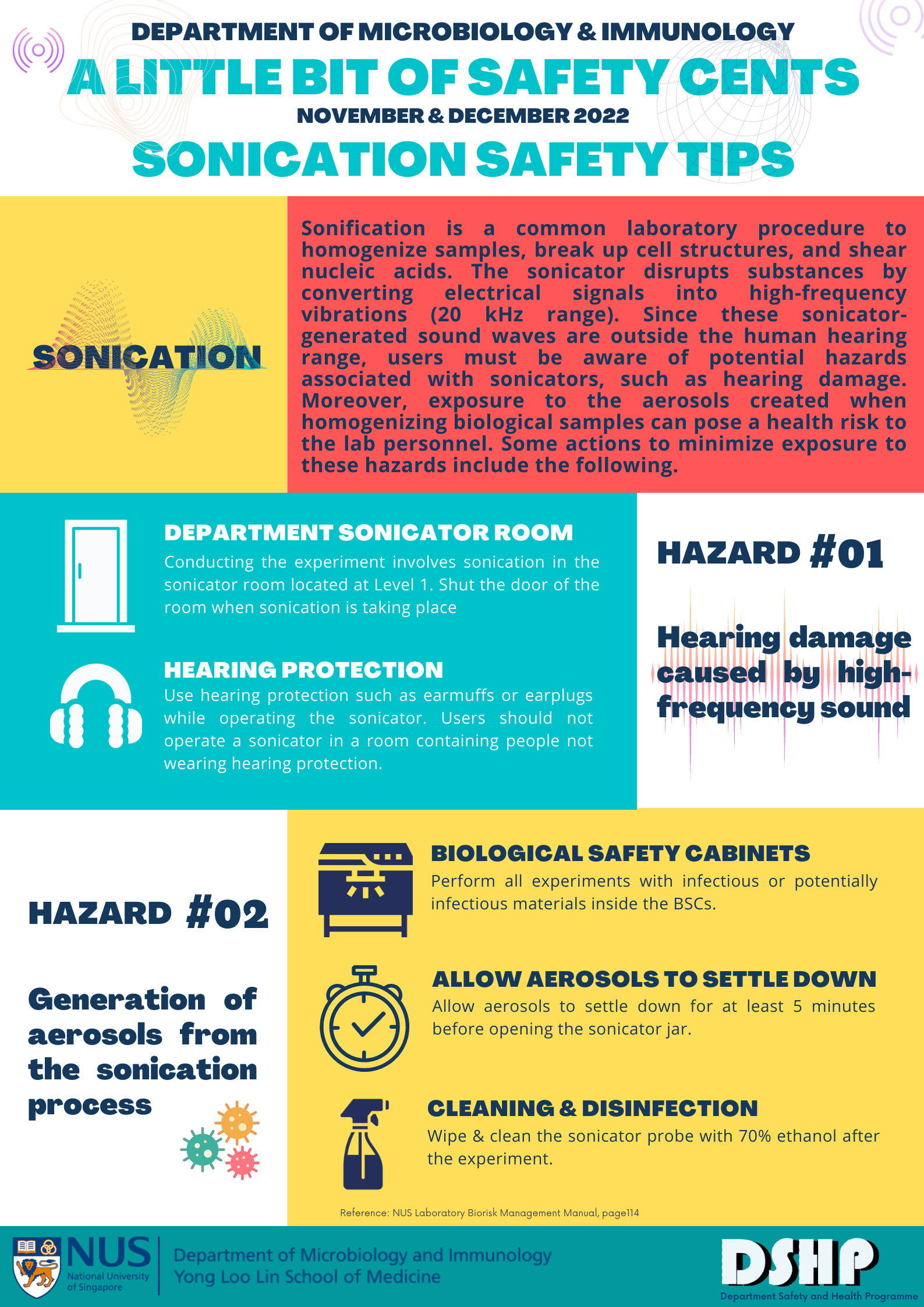
Sonication Safety Tips
Issue November & December 2022
The "Sonication Safety Tips" infographic provides essential guidelines for safe sonication procedures in the laboratory. It addresses two primary hazards associated with sonication. Firstly, it highlights the risk of hearing damage due to the high-frequency sound produced during the process. Users are advised to operate the sonicator in a designated sonicator room with the door closed to minimize exposure to noise. Additionally, they should use appropriate hearing protection, such as earmuffs or earplugs, and avoid operating the sonicator in the presence of individuals not wearing hearing protection.
The second hazard discussed is the generation of aerosols during sonication, particularly relevant when working with infectious or potentially infectious materials. To mitigate this risk, it is recommended to conduct experiments involving such materials inside biological safety cabinets (BSCs). After sonication, users should allow aerosols to settle for at least 5 minutes before opening the sonicator jar. Furthermore, proper hygiene is emphasized, including the cleaning of the sonicator probe with 70% ethanol after each experiment. These safety measures contribute to a safer laboratory environment by reducing the risk of hearing damage and potential exposure to hazardous aerosols.
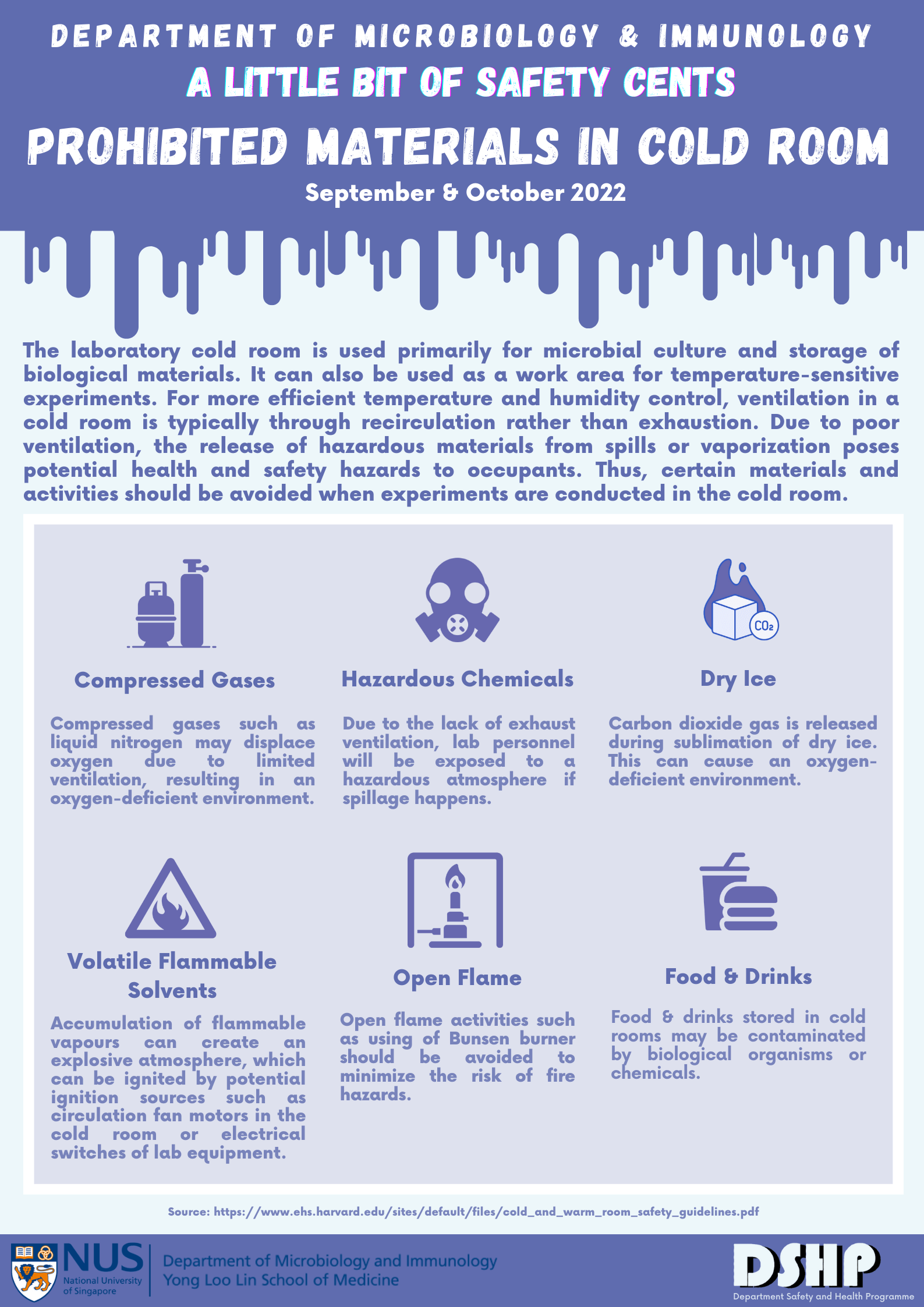
Prohibited Materials in Cold Room
Issue September & October 2022
The "Prohibited Materials in Cold Room" infographic provides essential information to ensure the safety and integrity of laboratory cold room environments. The cold room serves as a critical space for microbial culture, biological material storage, and temperature-sensitive experiments, often utilizing recirculation for temperature and humidity control. However, due to limited ventilation in cold rooms, the release of hazardous materials can pose health and safety risks to occupants. Therefore, certain materials and activities must be avoided within this environment.
Compressed gases like liquid nitrogen should be handled cautiously since they can displace oxygen, potentially leading to oxygen-deficient conditions. Hazardous chemicals should not be used due to the lack of exhaust ventilation, which could expose lab personnel to a hazardous atmosphere in case of spillage. Dry ice is problematic because it releases carbon dioxide gas during sublimation, creating an oxygen-deficient environment. Similarly, volatile flammable solvents can accumulate, potentially creating an explosive atmosphere that could be ignited by various sources within the cold room. Open flame activities, such as using a Bunsen burner, should be avoided to mitigate fire hazards. Lastly, food and drinks must not be stored in cold rooms as they can become contaminated by biological organisms or chemicals. Adhering to these guidelines is crucial for maintaining a safe and effective cold room environment in the laboratory.
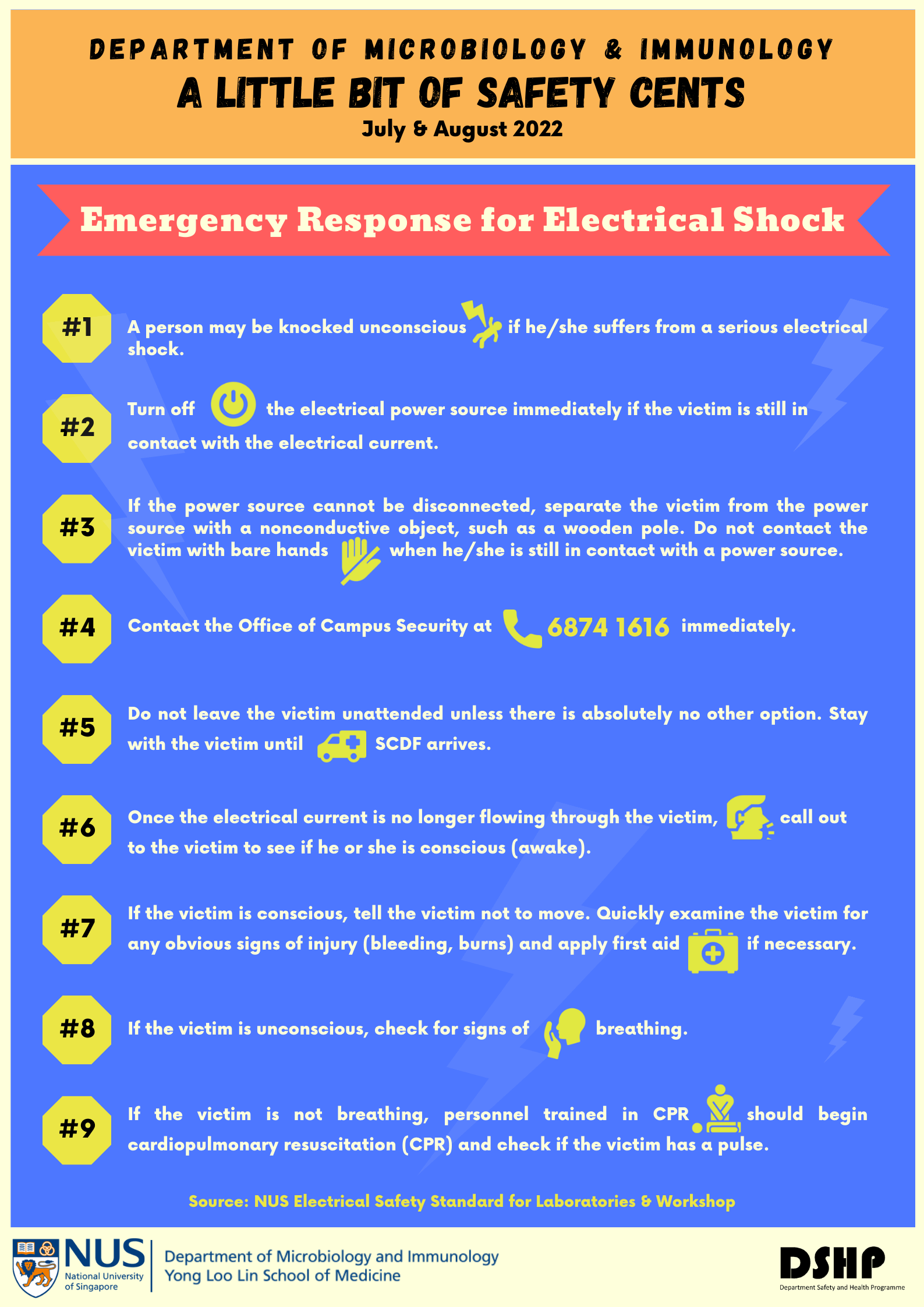
Emergency Response for Electrical Shock
Issue July & August 2022
The "Emergency Response for Electrical Shock" infographic offers a clear and concise guide for handling electrical shock incidents. When someone suffers a severe electrical shock, the initial steps are crucial for their safety. If the person is unconscious but still in contact with the electrical current, it is essential to turn off the power source immediately. If this is not possible, using a non-conductive object like a wooden pole to separate the victim from the power source is recommended. Contacting the Office of Campus Security is a priority to ensure that professional assistance is on the way. Importantly, one should not leave the victim unattended unless absolutely necessary. Staying with the victim until emergency services (SCDF) arrive is crucial. After ensuring the victim is no longer in contact with the electrical current, check if they are conscious. If conscious, advise the victim not to move and provide necessary first aid if there are visible injuries. If the victim is unconscious, check for signs of breathing. If there is no breathing, individuals trained in CPR should initiate cardiopulmonary resuscitation (CPR) and assess for a pulse. These steps help ensure a coordinated and potentially life-saving response to electrical shock incidents.
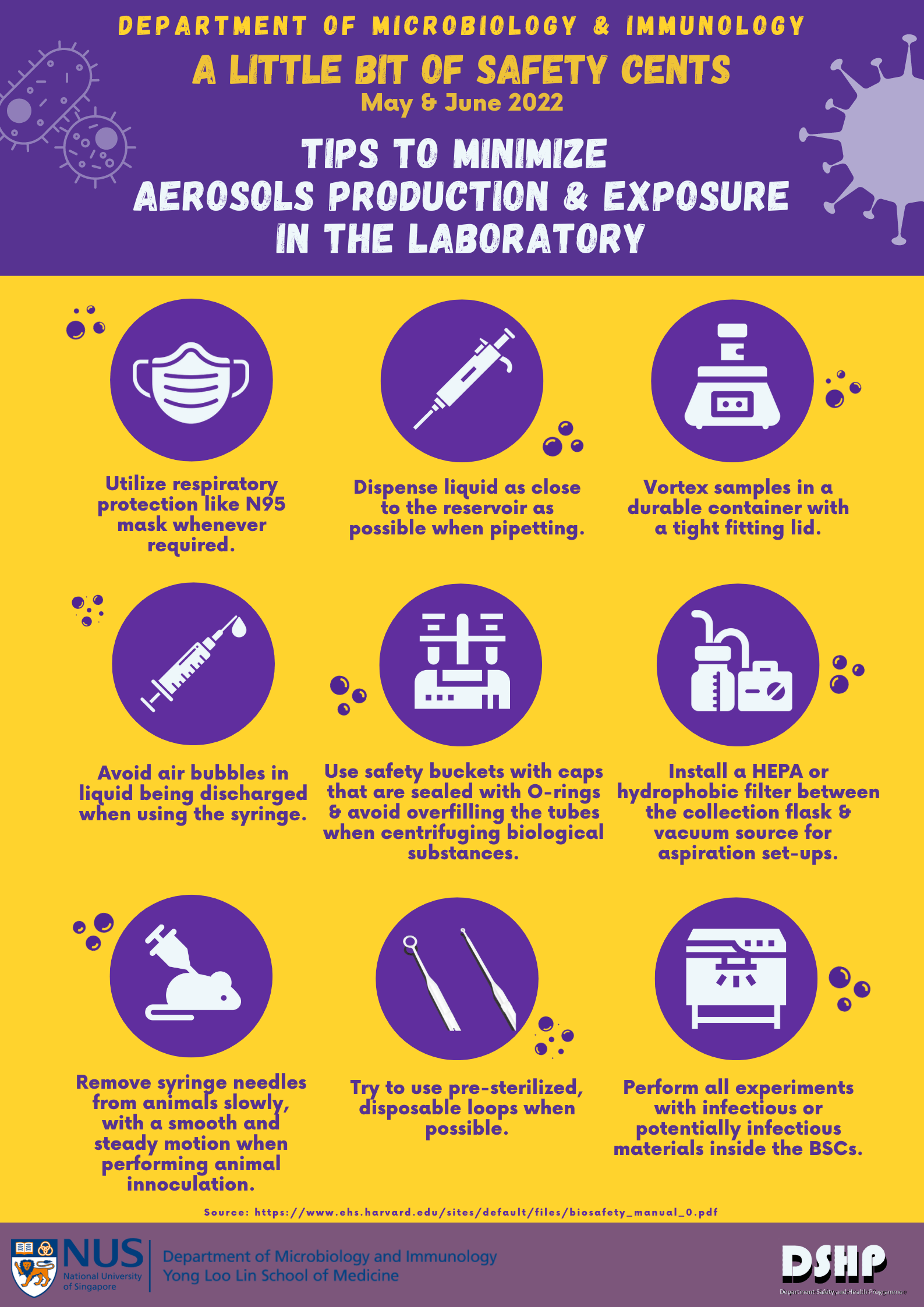
Tips to Minimize Aerosols Production and Exposure in the Laboratory
Issue May & June 2022
The "Tips to Minimize Aerosol Production & Exposure in the Laboratory" infographic provides valuable guidance for creating a safer laboratory environment. These tips focus on reducing the generation and exposure to potentially harmful aerosols. Recommendations include the use of respiratory protection, such as N95 masks when necessary, dispensing liquids close to the reservoir to minimize aerosol formation during pipetting, and vortexing samples in containers with secure lids. Additionally, the infographic suggests avoiding the formation of air bubbles when using syringes and using safety buckets with sealed caps and O-rings while centrifuging biological substances to prevent aerosol release. Installing HEPA or hydrophobic filters in aspiration setups and removing syringe needles from animals carefully are also highlighted to minimize aerosols. Lastly, conducting experiments with infectious materials inside biological safety cabinets (BSCs) is strongly advised. These practices collectively help mitigate aerosol-related risks in laboratory settings, ensuring a safer and more controlled work environment.
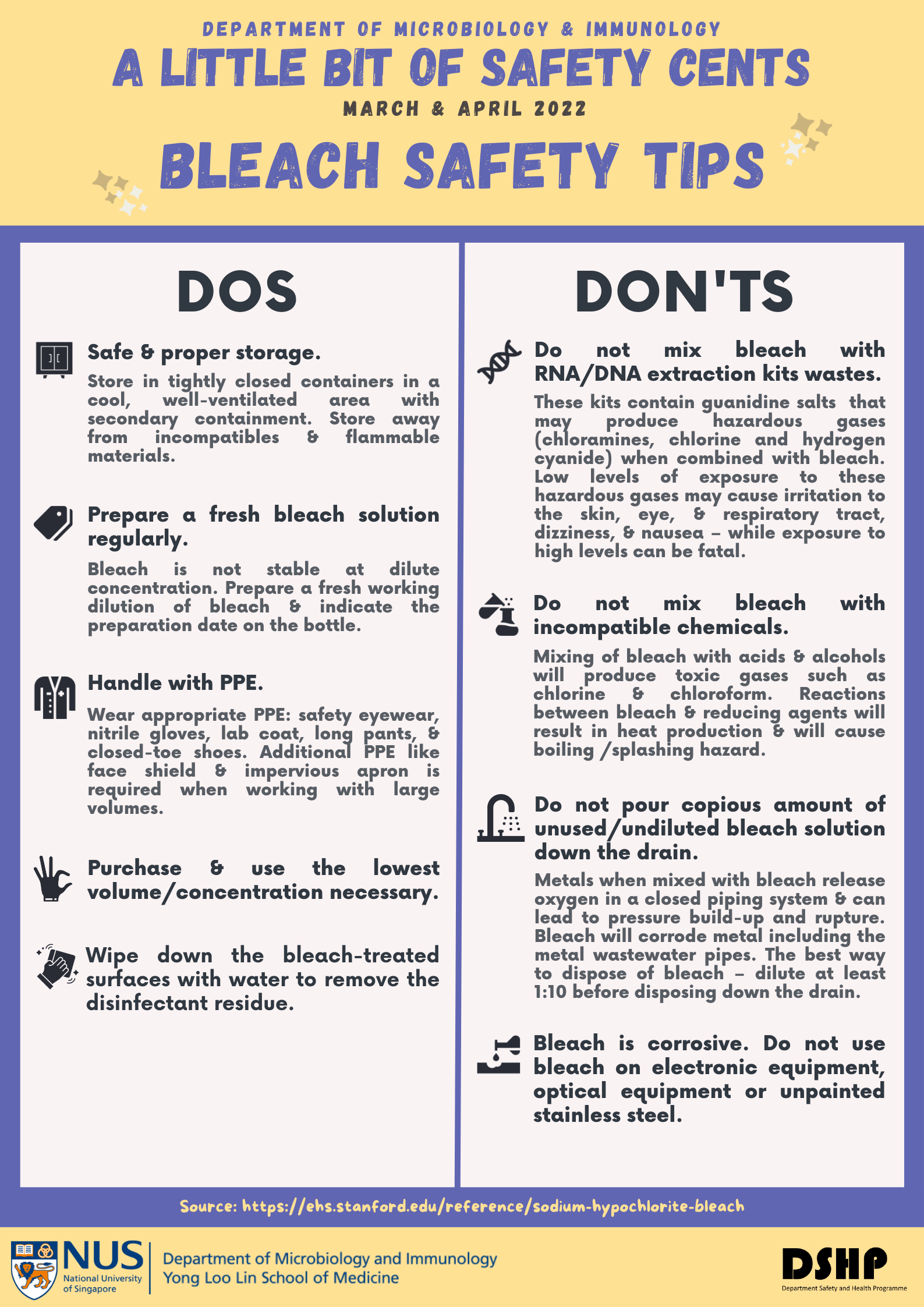
Bleach Safety Tips
Issue March & April 2022
The "Bleach Safety Tips" infographic provides essential guidelines for safe and responsible handling of bleach in laboratory and workplace settings. It emphasizes several key practices to ensure safety. These include the proper storage of bleach in tightly sealed containers, away from incompatible and flammable materials, as well as preparing fresh bleach solutions regularly due to its instability at dilute concentrations. The infographic highlights the importance of personal protective equipment (PPE) such as safety eyewear, nitrile gloves, lab coats, long pants, and closed-toe shoes when working with bleach. Additional PPE like face shields and impervious aprons are required when handling larger volumes. Moreover, the guidance stresses the purchase and use of the lowest necessary volume and concentration of bleach. It advises wiping down bleach-treated surfaces with water to remove disinfectant residue. Importantly, it cautions against mixing bleach with DNA/RNA extraction kit wastes or incompatible chemicals, as such combinations can produce hazardous gases and reactions. The infographic also warns against pouring excessive amounts of undiluted bleach down drains, as it can lead to pressure build-up in piping systems and corrode metal wastewater pipes. Lastly, it emphasizes that bleach should not be used on electronic equipment, optical equipment, or unpainted stainless steel due to its corrosive nature. These comprehensive safety tips promote the responsible use of bleach and reduce the risk of accidents, exposure to hazardous chemicals, and damage to equipment and infrastructure.
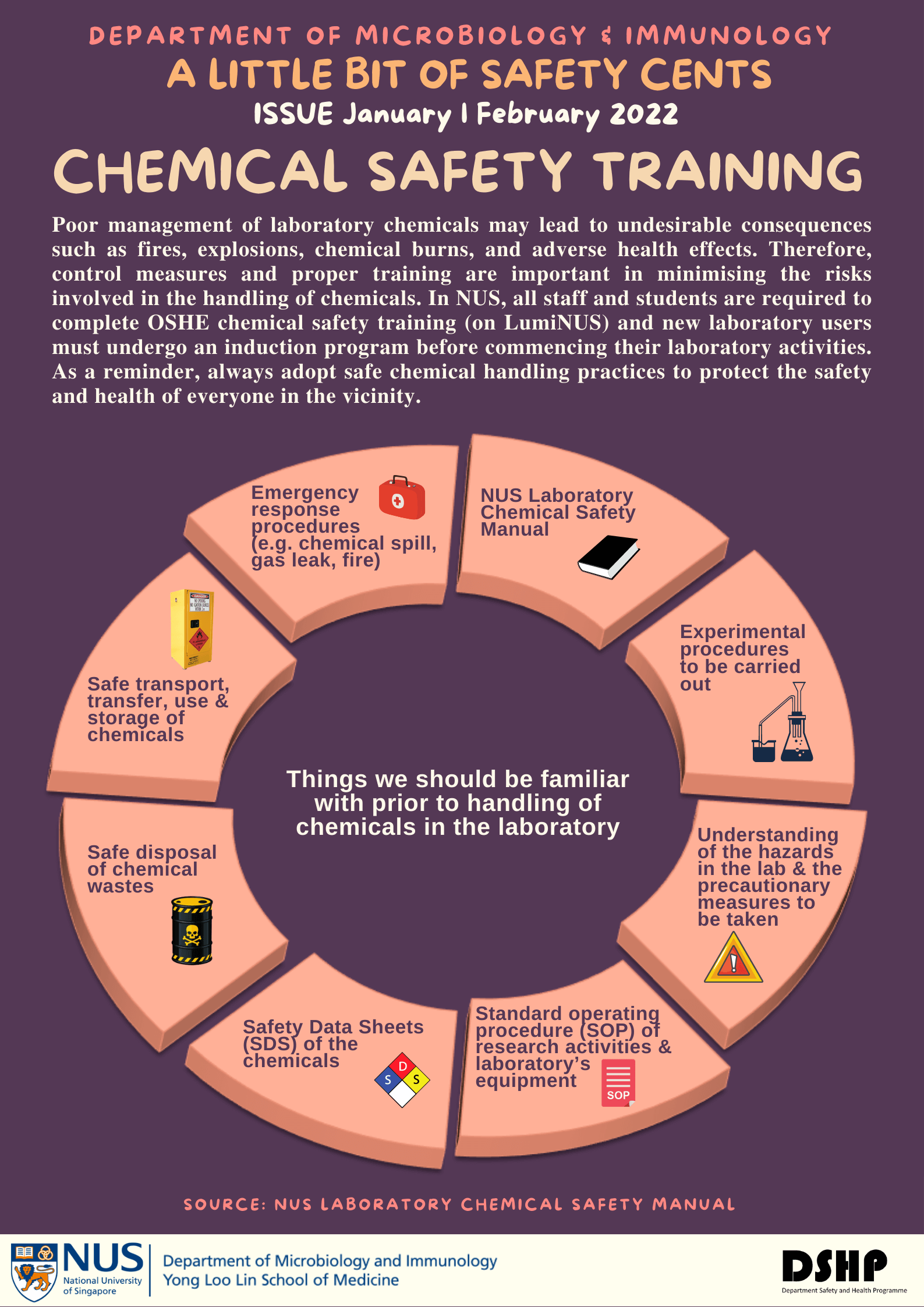
Chemical Safety Training
Issue January & February 2022
The "Chemical Safety Training" infographic underscores the critical importance of proper chemical management and training to mitigate potential hazards in laboratory environments. It emphasizes the consequences of inadequate chemical handling, which can include fires, explosions, chemical burns, and health risks. To address these concerns, NUS requires all staff and students to complete OSHE chemical safety training and mandates an induction program for new laboratory users. The goal is to ensure that everyone involved in laboratory activities is well-prepared to handle chemicals safely. The infographic provides a list of key areas of knowledge that individuals should be familiar with before working with chemicals in the laboratory. These include emergency response procedures for scenarios like chemical spills, gas leaks, and fires. Understanding the NUS Laboratory Chemical Safety Manual, experimental procedures, hazards, precautionary measures, research activities, and equipment SOPs are also essential. Knowledge of Safety Data Sheets (SDS) for chemicals, safe disposal of chemical waste, and safe practices for transporting, transferring, using, and storing chemicals further contribute to a comprehensive chemical safety framework. In summary, the infographic serves as a reminder to prioritize safety and health when handling chemicals and to ensure that all necessary precautions and knowledge are in place for safe laboratory operations.